Oct 19, 2025 – Dharma Q&A for Multicultural Families with Ethnic Koreans, Youth Festa Workshop
Hello. Today, a Dharma Q&A for multicultural families and a Youth Festa Supporters Workshop are being held at the Jungto Social and Cultural Center.
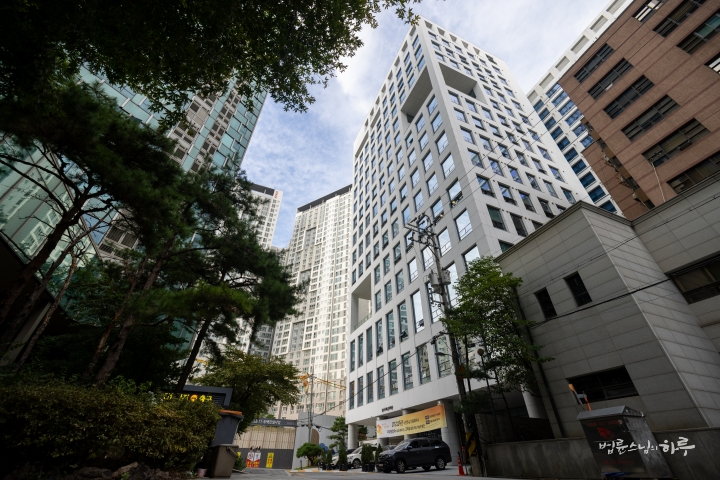
After completing his morning practice and meditation, Sunim headed to the Jungto Social and Cultural Center. He began his day at 8 AM with a meeting with the Jungto Society Standing 1000-Day Preparation Committee in the 10th floor conference room.
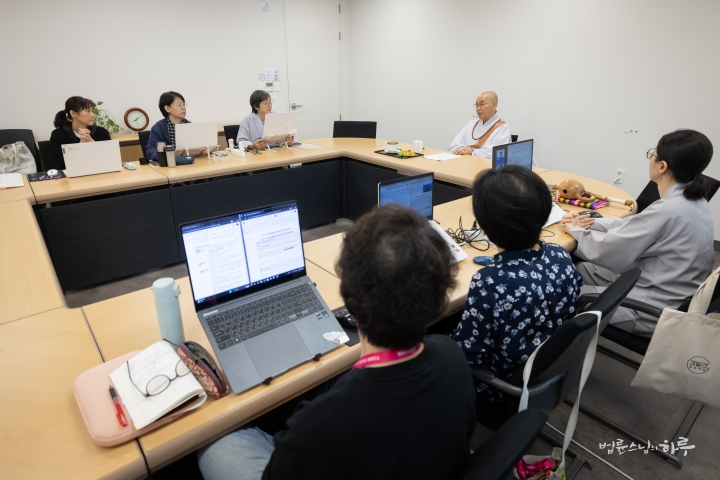
First, Dharma Teacher Beopjeong, the chairperson of the 1000-Day Preparation Committee, presented the agenda items for discussion. The 1000-Day Preparation Committee is preparing the business plan and organizational restructuring for Jungto Society’s 2-2nd 1000-Day Practice. The committee members sought Sunim’s advice on issues they were contemplating, including improvements to the leading member system and supplementary measures for the engaged volunteer system. The final question concerned the position rotation system.
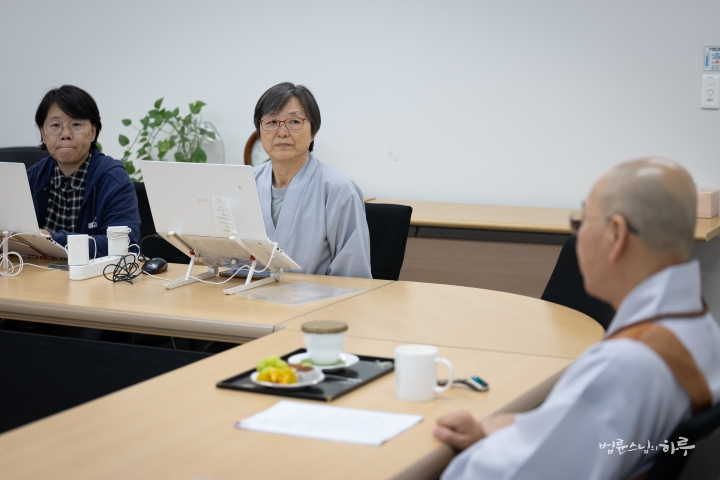
“To what extent should we apply the position rotation system in specialized areas that require work continuity?”
Sunim explained the purpose behind Jungto Society’s establishment of the position rotation system.
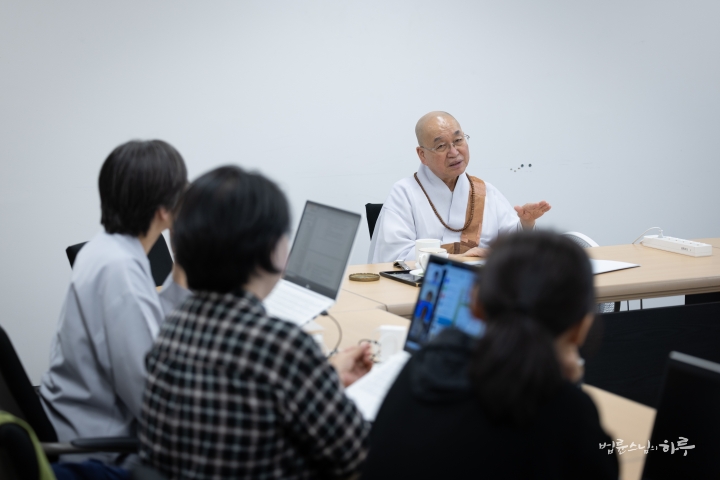
“The reason Jungto Society has a position rotation system is to prevent practitioners from becoming attached to their work. This is because karma forms when we repeat the same tasks. While repetition can increase efficiency, it also binds us to habits and attachments. That’s why, since the Buddha’s time, monks have practiced by wandering without staying in one place. This can be seen as a method to free oneself from attachment.
Position Rotation Is a Form of Practice
The duty of practitioners who join Jungto Society is not ‘work’ but ‘practice.’ Therefore, positions should not become like careers. The core principle of Jungto Society is to ‘work as given without attachment.’ If we value this principle, we should cherish the perspective of practice more than efficiency and expertise. However, realistically, to carry out social action activities, a certain level of expertise and efficiency is needed, which leads to areas where position rotation doesn’t function properly.
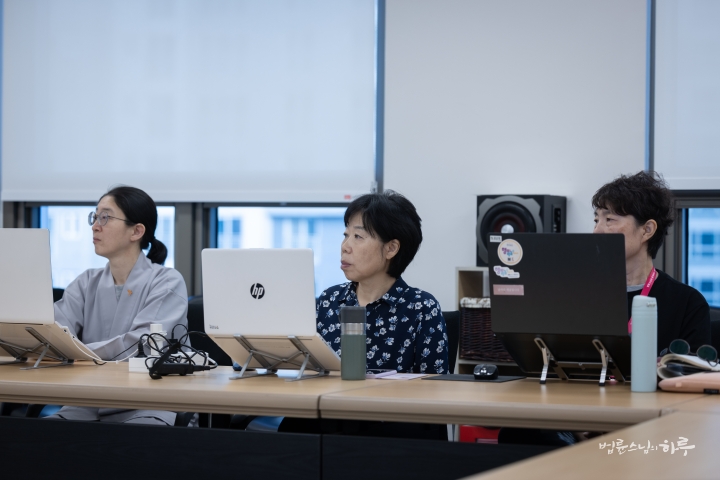
Particularly, since Jungto Society operates on the principle of volunteerism, concerns about inefficiency continue to arise. For example, while the Jungto Social and Cultural Center is managed by about 150 volunteers sharing various roles, it could be operated more efficiently with just 7 professional managers. The maintenance of online systems would also be easier if handled by professionals. However, if we did that, Jungto Society would be no different from other religious organizations. As Jungto Society is a community of practitioners, we aim for a structure where practice takes priority over efficiency. Therefore, we must accept a certain degree of inefficiency.
Most lay Sangha members who are resident practitioners at Jungto Society naturally grow to expert level through long-term activities. Many have become skilled through extensive experience in areas such as producing ‘A Day in the Life of Sunim,’ video editing, and overseas relief work. However, even they must rotate positions after a certain period. Recently, though, with the decrease in new recruits, the principle of position rotation hasn’t been functioning properly. As Jungto Society grows larger, we need more specialized personnel, but at the same time, to maintain our duty as practitioners, we must place the perspective of practice at the center rather than efficiency.”
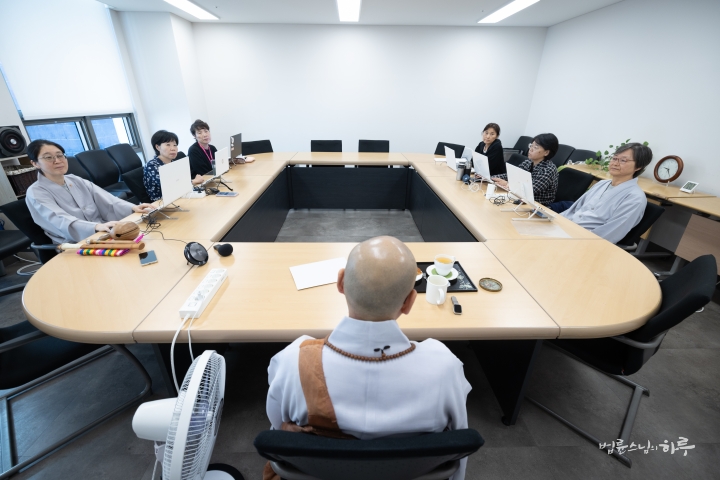
“What will happen to Jungto Society if job rotation becomes increasingly difficult and cannot be properly implemented in the future?”
“If that happens, people will naturally become fixed in their positions. Over time, each person’s area of responsibility will become their exclusive domain, and this could even lead to the formation of factions. Particularly, certain specialized fields will become work that only a few people can do, making it difficult for others to access. From a secular perspective, such specialization might be a natural progression, but it becomes a major obstacle to the continuation of Jungto Society as a community of practitioners.
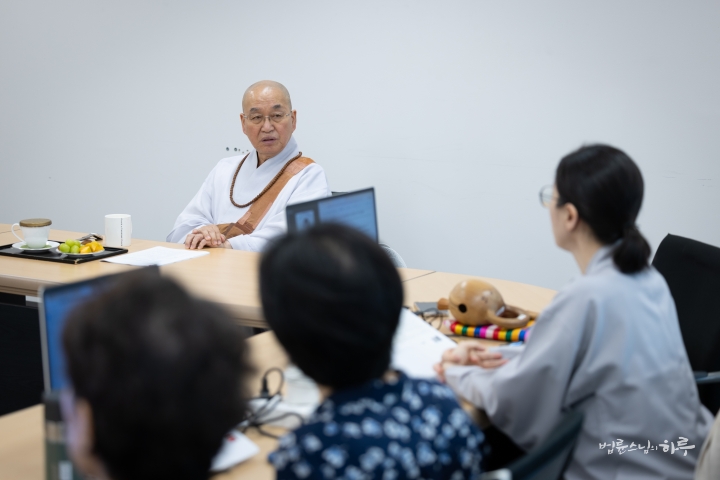
Therefore, we must clearly recognize this contradiction and find a harmonious direction. While maintaining the principle of job rotation, we may need a flexible operating system that allows for certain exceptions when necessary. However, we must not forget that the core purpose of the job rotation system is to let go of attachment and prevent the formation of factions.”
Although there were many more questions to ask, it was time for Sunim to conduct a Dharma Q&A for multicultural families, so the meeting was hastily concluded.
In front of the conference room, Ms. Aung, who had come to volunteer as a Myanmar interpreter today, was waiting for Sunim. Originally, Sunim was scheduled to give a Dharma Q&A lecture for multicultural families from Myanmar today, but it happened to be a day when various festivals and events for Myanmar people were being held. Unfortunately, the Dharma Q&A for Myanmar people was rescheduled for another time, and today it was decided to hold a Dharma Q&A lecture for Koryo-saram (ethnic Koreans from Central Asia). Instead, Sunim had a brief tea conversation with the Myanmar interpreter volunteer.
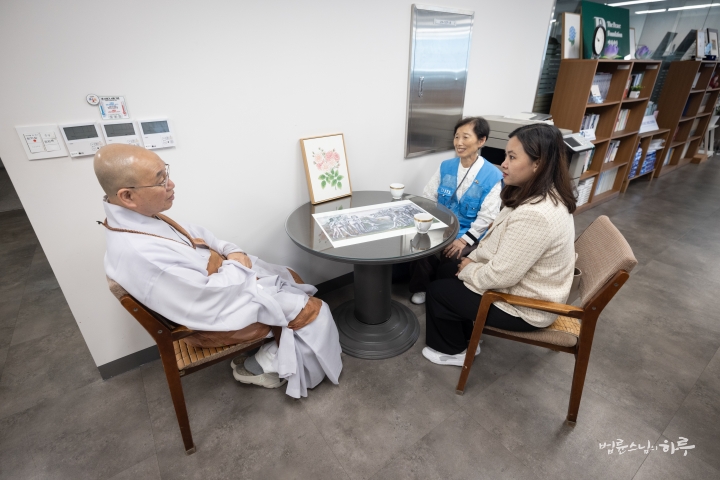
After exchanging warm greetings, Ms. Aung introduced herself. Ms. Aung spoke Korean very well, having obtained his Ph.D. in Korean Language from Kyung Hee University.
“Where is your hometown?”
“It’s Monywa in Sagaing Region.”
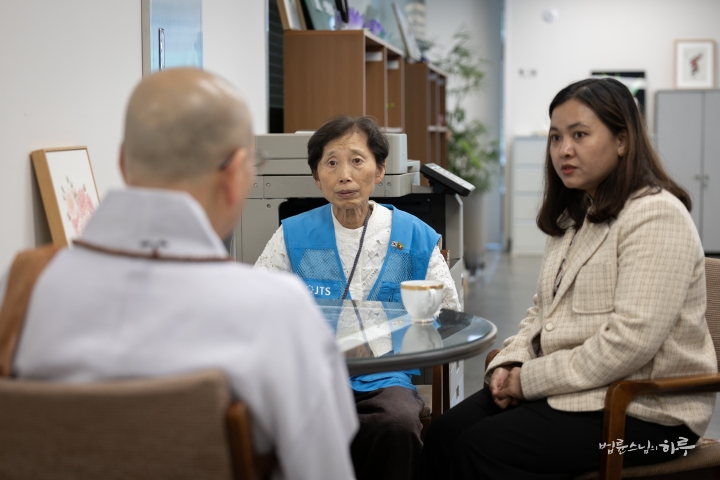
“JTS is providing food aid and school construction support to refugee camps in Sagaing Region that were affected by the earthquake. We recently visited there for a survey.”
“Yes, I’ve heard about it and am aware of it.”
“Approximately how many Myanmar people are in Korea?”
“About 20,000 people.”
“Next time, we’ll arrange another lecture on a date that doesn’t conflict with other events. Please come to volunteer as an interpreter then too.”
After a light conversation, they headed together to the underground auditorium for the multicultural family Dharma Q&A.
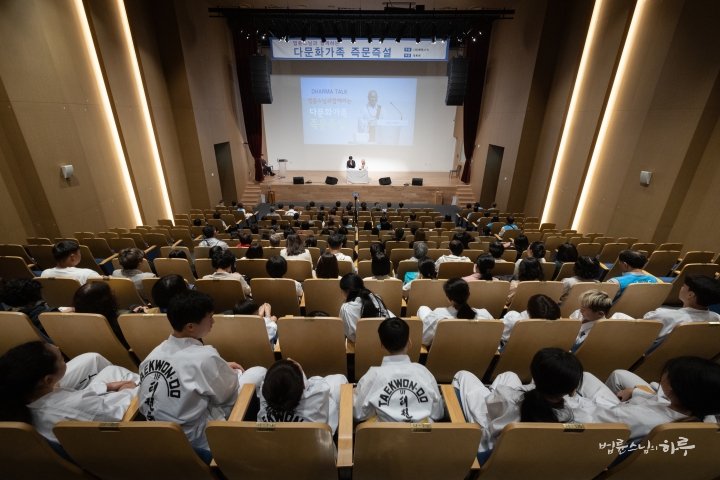
At 10 AM, about 70 Koryo-saram and 10 Myanmar people were seated in the underground auditorium. Before starting the dialogue with Sunim, students from the JTS Ansan Multicultural Center’s Taekwondo class gave a Taekwondo demonstration.

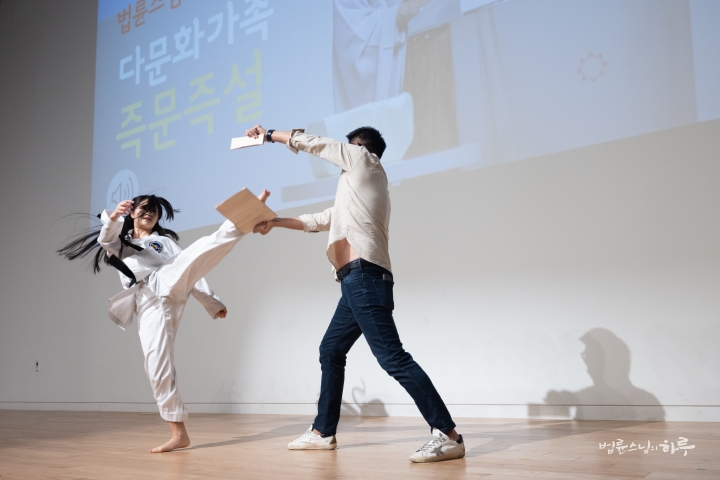
First, the youth demonstration team showed a high-difficulty performance, followed by the children’s demonstration team presenting cute and passionate poomsae and breaking demonstrations. The children’s adorable movements brought laughter and applause from the audience.
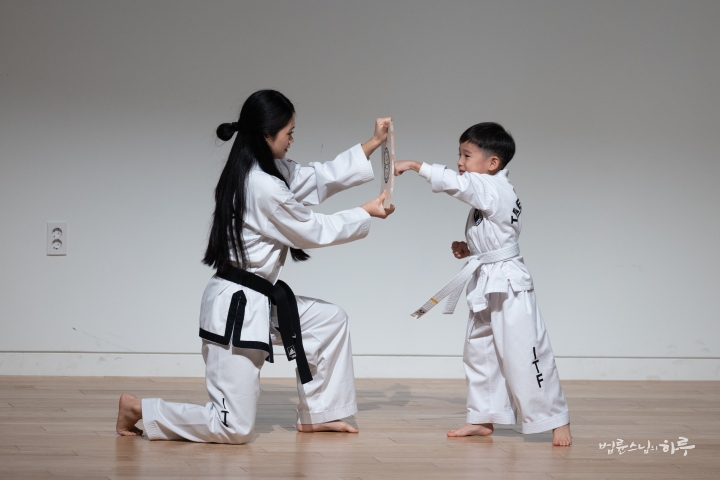
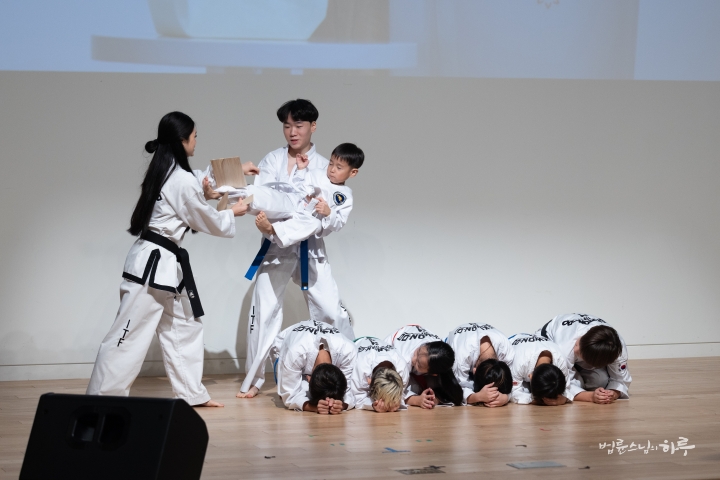
Sunim took a commemorative photo with the youth and children who performed the Taekwondo demonstration.
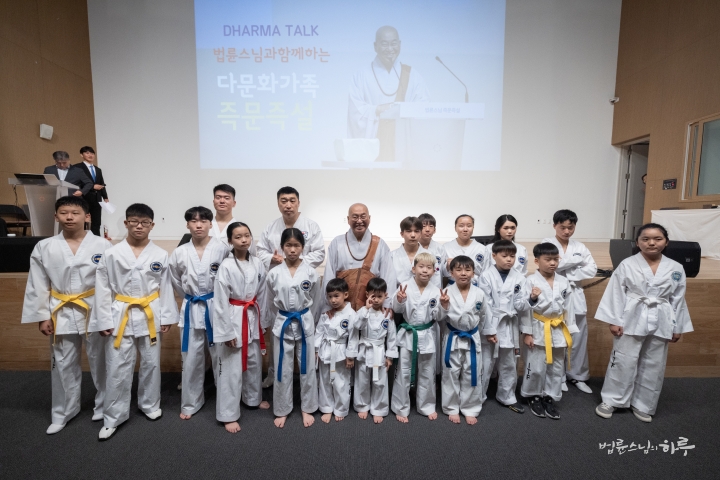
After watching an introductory video about Sunim together, Sunim walked onto the stage to applause. Sunim began the dialogue by introducing the migration history of the Koryo-saram.
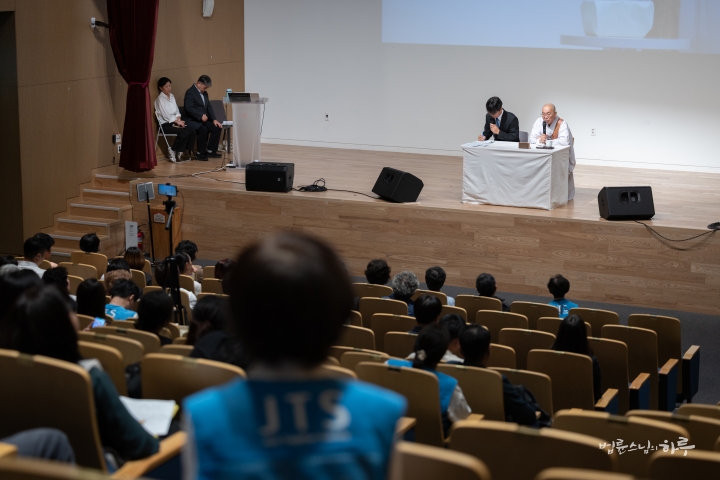
“The current Maritime Province area, where Vladivostok is located, was originally inhabited by the Manchu people. When the Second Opium War broke out in China in 1858 and the Qing Dynasty was defeated, the Treaty of Beijing was signed. Britain received massive reparations along with the cession of Hong Kong, and the Qing Dynasty was forced to open ten additional ports. During this negotiation process, Russia played the role of mediator, and in return, received the current Maritime Province region.
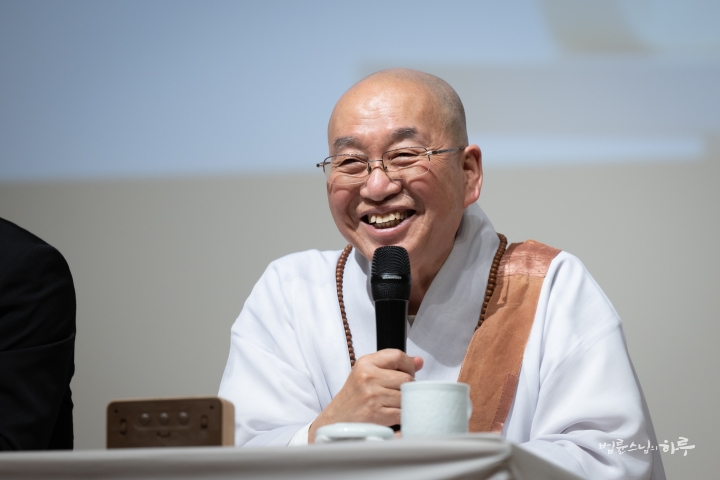
From the Maritime Province to Central Asia: The History of Tears and Pioneering of the Koryo People
Long before that, our people had already crossed the Tumen River due to the hardships of life in Joseon and began settling in what is now the Yanbian Korean Autonomous Prefecture, known as North Jiandao, where they cultivated the wasteland. They also crossed the lower reaches of the Tumen River and advanced to the present-day Kraskino area in the Maritime Province, where they settled. Later, as Russia took control of the Maritime Province, the Koreans living there naturally came under Russian jurisdiction. While Russian records indicate that Korean immigration began in 1863, in reality, they had already been establishing their livelihoods there much earlier. The number of immigrants grew rapidly, reaching 100,000, then 200,000, and eventually 300,000. Initially, they formed Korean villages around Vladivostok, but as the city expanded, the Russian government relocated Koreans to the outskirts, where new villages, called “Sinhanch’on (New Korean Village),” were established.
Vladivostok holds significant meaning in our nation’s independence movement history. Although Ahn Jung-geun assassinated Ito Hirobumi in Harbin, his base of operations was in Vladivostok. General Hong Beom-do, who led the Battle of Bongodong, also originally conducted his independence activities centered in the Maritime Province. The first provisional government after the March 1st Movement was also established in Vladivostok. In this way, the Koreans residing in the Maritime Province fought against Japanese aggression, sometimes receiving protection from the Russian government, and at other times suffering harm from the Russian government due to Japanese pressure, leading difficult lives caught between the two nations.
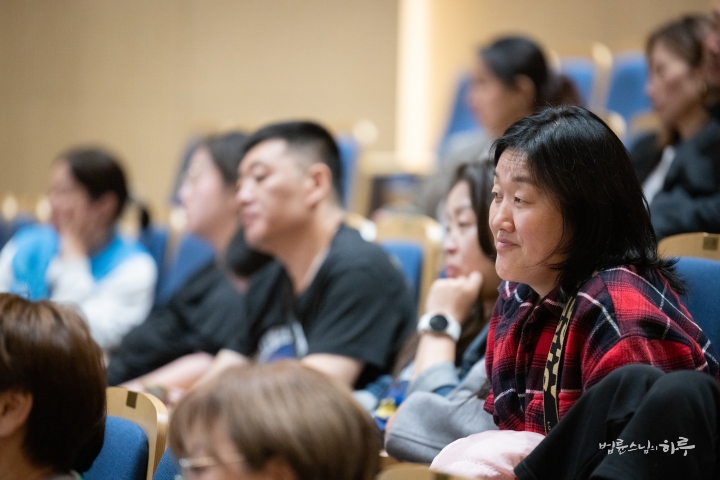
After the Russian Revolution and the establishment of the Soviet regime, independence activists in the region faced a critical choice. To continue their independence movement, they had to join the Soviet army; otherwise, they had to leave. At that time, the Communist International (Comintern) upheld the principle of “one country, one party,” recognizing only the communist party of each nation. As a result, Korean independence army organizations in the Maritime Province had no choice but to be incorporated into the Soviet Communist Red Army or be disbanded. General Hong Beom-do also had to disband the Korean Independence Army Corps and eventually made a living as a farm manager.
In 1937, as tensions between the Soviet Union and Japan escalated ahead of World War II, the Soviet government regarded the Koreans in the Maritime Province as nationals of the Japanese Empire and potential spies. Consequently, approximately 170,000 Koreans were forcibly relocated to Central Asian regions including Uzbekistan, Kazakhstan, and Tajikistan. During this process, countless people lost their lives to starvation and disease, while survivors began new lives by cultivating farms in unfamiliar lands. Some settled so successfully that they received hero titles from the Soviet Union, but General Hong Beom-do ended his life working as a theater attendant.
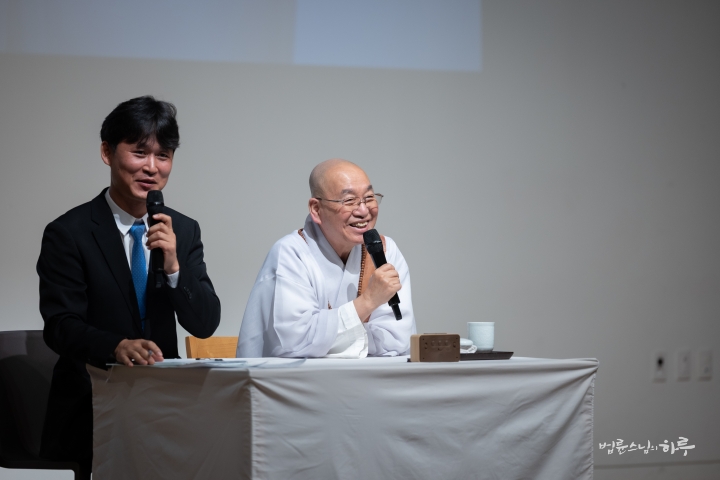
The Pioneer Spirit That Cultivated Wastelands, Continuing the Roots of Goryeoin
After the dissolution of the Soviet Union, the Russian government officially apologized for this forced relocation policy. Since then, approximately 50,000 Goryeoin have returned to live in the Maritime Province, seeking their parents’ homeland. Currently, about 600,000 Goryeoin reside in Russia, Central Asia, and other former Soviet territories.
You are the descendants of those ancestors, people who have returned to your homeland in search of your ancestral roots. Your ancestors pioneered wastelands and built foundations for life, and that pioneering spirit has become a great asset to us today. I hope you too will inherit that spirit and once again boldly forge your own path here in Korea, this unfamiliar land.”
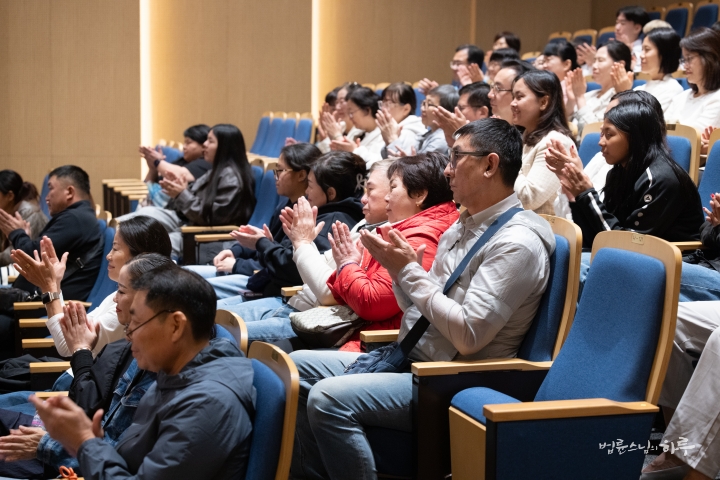
Hearing about the migration history of the Goryeoin made everyone feel solemn. Following this, there was time for dialogue with Sunim about the difficulties of life in Korea. Anyone could raise their hand and ask Sunim questions.
The Goryeoin participants expressed the practical difficulties they face in Korea. They said that compared to compatriots from other countries, it is more difficult to obtain visas, and the burden of health insurance premiums is heavy, making life challenging. They particularly expressed frustration about not receiving proper treatment despite being descendants of patriots who fought for independence. Among them, one participant raised the issue of unreasonable discrimination in Goryeoin visa issuance and asked Sunim a question.
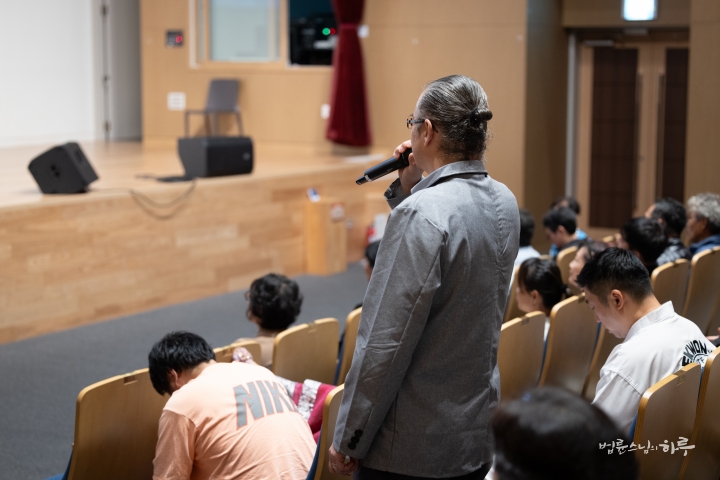
Why Should I Face Discrimination as a Descendant of Independence Activists?
Sunim explained in detail the historical background of why such differences exist even among the same Goryeoin due to different nationalities. He then talked about how to view this reality and what mindset to adopt to live more happily in the current situation.
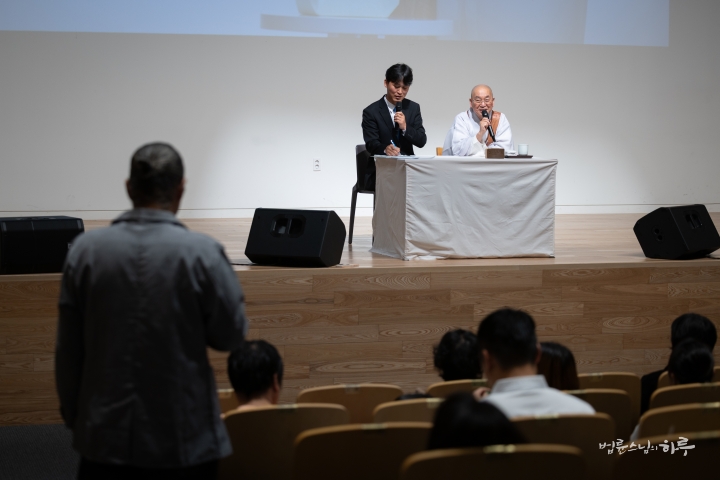
“Although I am not a government official, after hearing your stories today, I think I need to look into why some people cannot receive overseas Korean visas (B-2 visas). I will investigate why such differences exist and whether there are ways to obtain them. Since the issues of granting citizenship or providing support to immigrants who come to Korea are matters of law, I will meet with members of the National Assembly to find ways for institutional improvements.
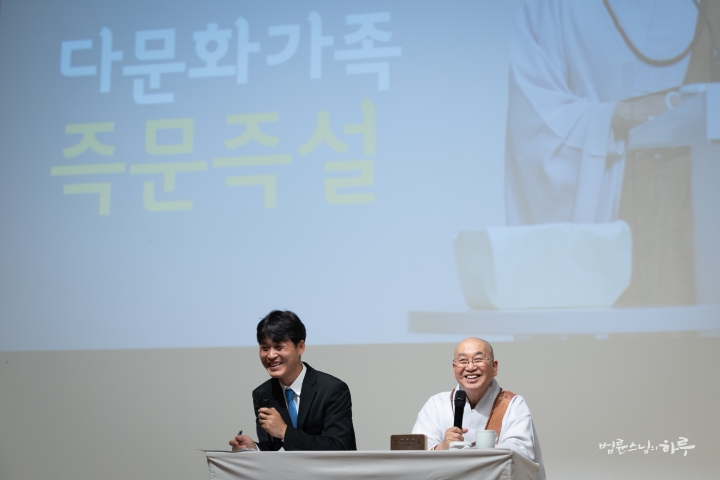
However, what I want to say is that such systems can change at any time. So now, I suggest changing your perspective and thinking, ‘I should be grateful that I was able to come to South Korea. If I can work and make a living here, that’s enough.’ I hope you will actively pioneer your life with this mindset.”
“I believe that if South Korea grants Korean citizenship to Goryeoin like us, it could solve one of the country’s major problems. Korea has now become a country with a declining population due to low birth rates. However, unlike Koreans, most of us Goryeoin have large families. When we get married, we have two, three, or even four children. These days, many Koreans delay marriage or, even when married, choose to raise pets instead of having children. But our Goryeoin children attend Korean schools, learn Korean, and naturally acquire Korean culture and ways of thinking. There’s no significant language barrier. The parents work diligently in jobs and factories that Koreans tend to avoid, faithfully paying taxes and health insurance premiums. Most of the money we earn is spent living in Korea. So I hope that in the future, all Goryeoin who want citizenship can obtain it more easily. If that happens, we can live proudly as members of this country, and at the same time, I believe it will help solve South Korea’s population decline problem to some extent.”
“I agree. I will make that proposal.”
“Thank you.”
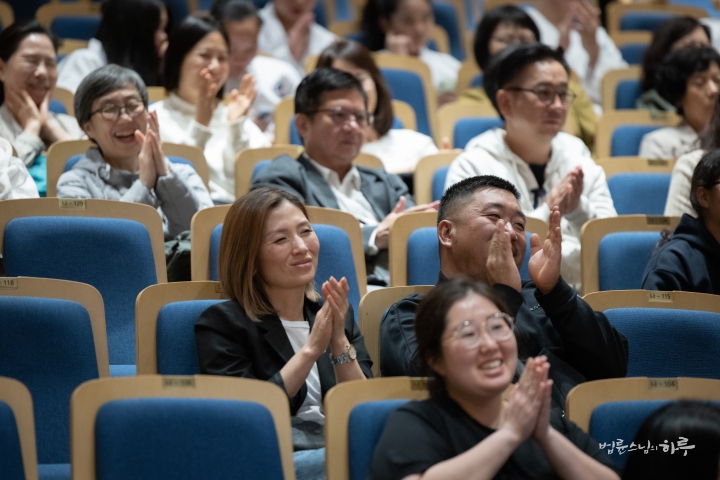
“We always live in conditions that are lacking. But if we harbor complaints about those shortcomings, our daily life inevitably becomes painful. If you’re going to live complaining, it might have been better not to come to South Korea at all. What I want to say is that South Korea is not a country where everything is perfect. Even young Koreans these days say they’re ‘living in hell.’ That’s why some people, trying to escape that suffering, even go to places like criminal organizations in Cambodia. The fact that they make such choices despite living in such a good country shows how great their inner dissatisfaction and frustration must be.
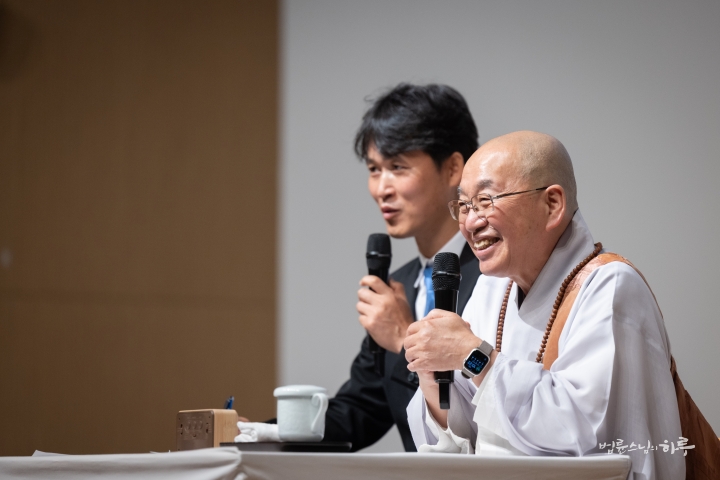
Life never goes as planned. You all have various difficulties, but I hope you won’t lose hope and think positively, ‘Coming to South Korea and working here is better than before.’ As a citizen of South Korea, I will also work to help improve the institutional irrationalities and discrimination issues you’ve mentioned.
Listening to your stories makes me think, ‘Should I go into politics to solve these problems?’ I’m joking. But that would be the way to directly solve your problems, wouldn’t it? Now, let’s continue our conversation after watching the performance.”
They then took a short break. Kim Eun-seon and Choi Ye-ji from the creative music group Geomungo Jari performed on the geomungo, a traditional Korean instrument.
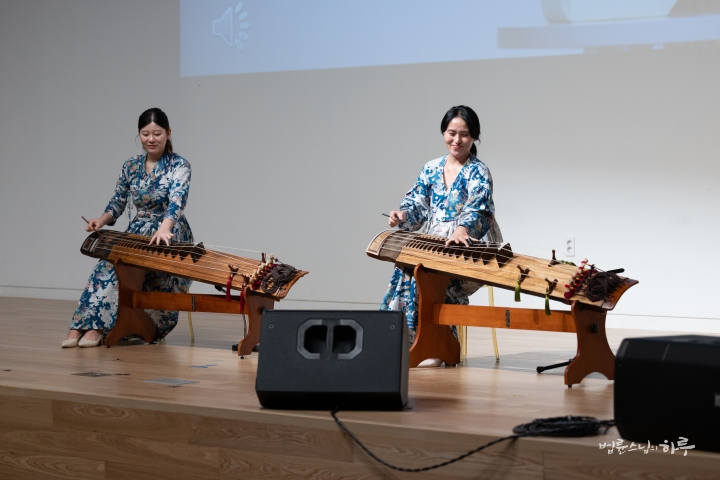
They seamlessly performed two pieces: “Fly Me to the Moon” and “Chulgang.” The performance of “Chulgang” particularly expressed the rhythm of heating steel with two geomungos, as if depicting the lights of an industrial site, creating an exciting atmosphere.
Next, Nai Chi Nu Nu from Myanmar sang a Myanmar song with a beautiful voice and received great applause.
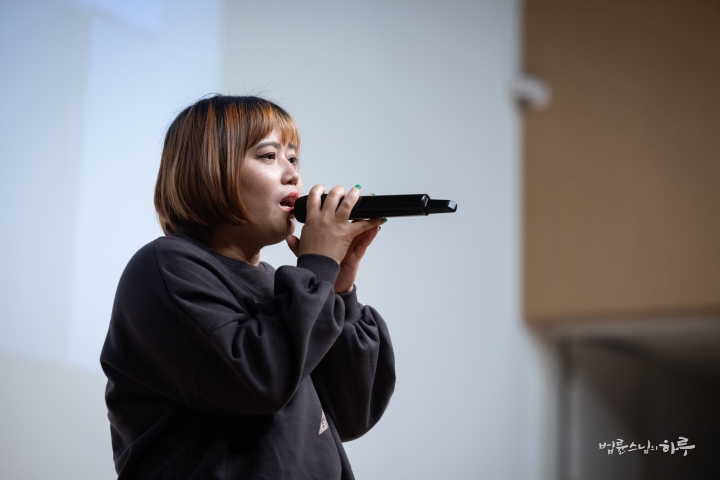
Following that, Goryeoin Cha In-ho, Yang Dmitri, and Yang Angelina sang “Arirang” joyfully. The audience also sang along with “Arirang,” and the performance hall became one. It was a warm moment of empathy, transcending barriers of language and culture, sharing homeland and longing.
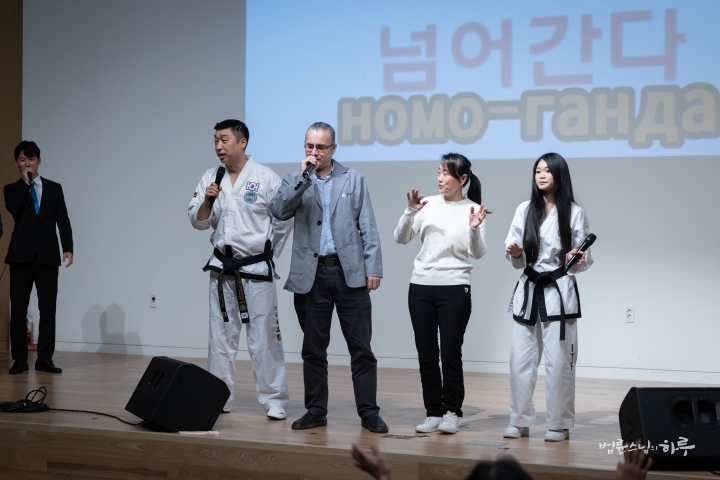
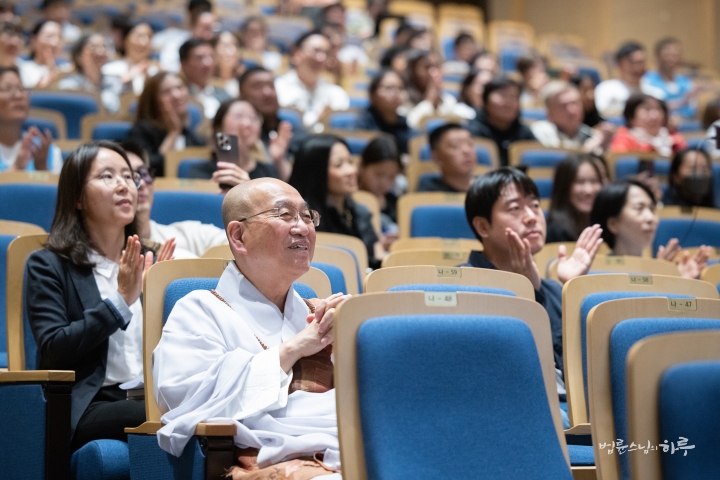
Finally, Sunim came up on stage to give closing remarks.
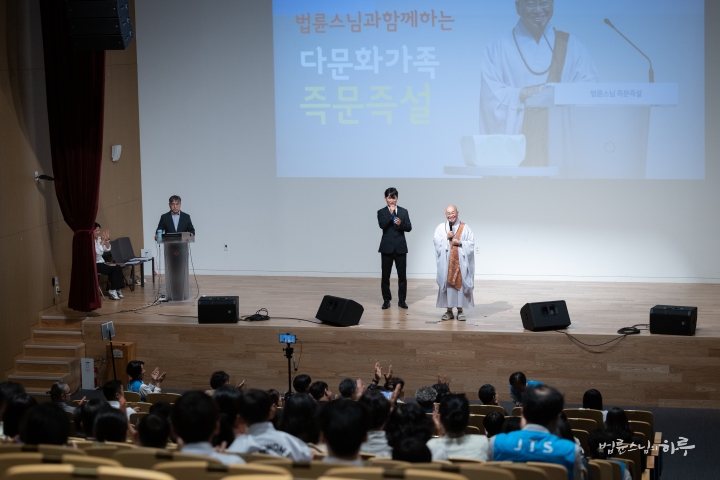
“Today was meant to be a day for you to enjoy yourselves, but bringing up your migration history has made the atmosphere rather solemn.
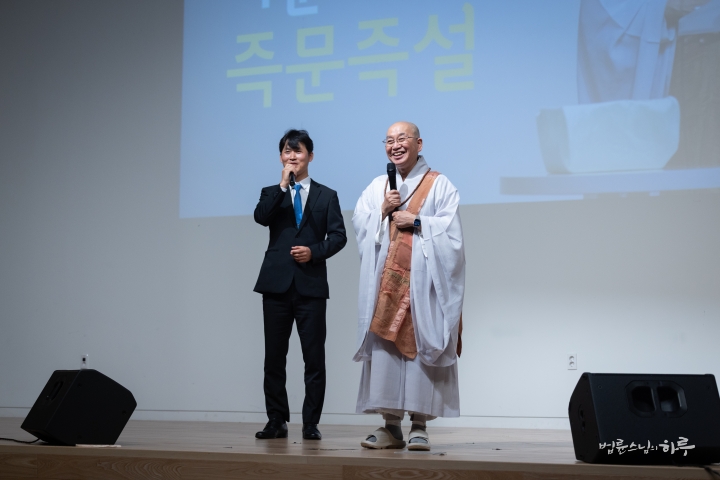
Before the COVID pandemic, I used to visit Kraskino, Ussuriysk, and Vladivostok at least once a year. Since these regions were historically under Balhae’s rule, I would personally visit independence movement sites and Balhae fortresses. Although I haven’t been able to go to Central Asia to see where you lived directly, I know your history and stories well through various channels. I sincerely applaud your efforts in continuing your immigrant life after returning to Korea. I hope you can now live comfortably thinking, ‘I won’t have to leave for another place again. This is my final homeland, where I will put down roots.’
While there are limits to what the government can do, I will make proposals to the government regarding aspects that could help with your settlement. Although there isn’t much I can directly help with, I will continue to make steady efforts to provide even small assistance to your lives through the JTS Multicultural Center.
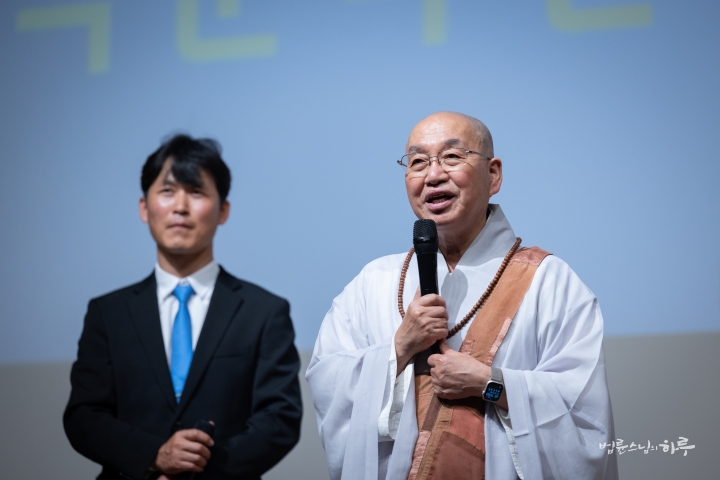
Thank you to everyone who performed today with taekwondo, geomungo, and singing. After the event, a simple meal has been prepared, so please enjoy it. You’re also welcome to have tea on the second floor and chat with each other. I hope everyone has a pleasant and comfortable day.”
The multicultural family Dharma Q&A session concluded with loud applause.
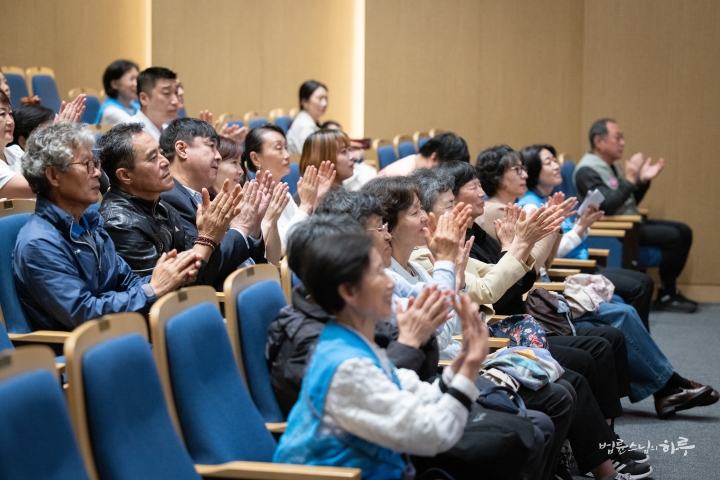
After taking a group photo together, participants had time to tour the Jungto Social and Cultural Center.
“Goryeoin, fighting!”
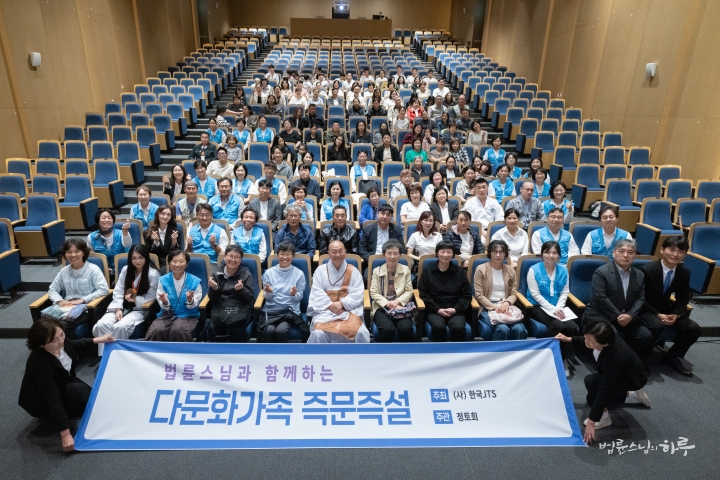
Divided into three teams, participants toured throughout the Jungto Social and Cultural Center from the third basement floor to the 15th-floor rooftop, learning about the various social action activities that Jungto Society conducts. Coincidentally, the JTS 32nd anniversary photo exhibition was being held on the third basement floor and second floor, allowing visitors to see the history of JTS at a glance.
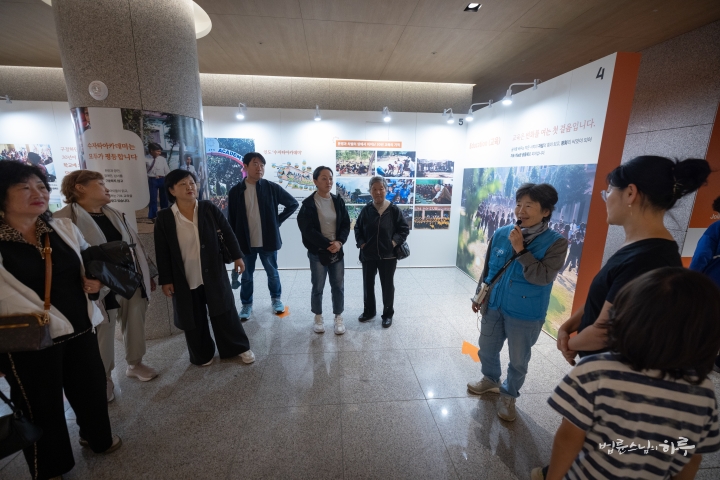
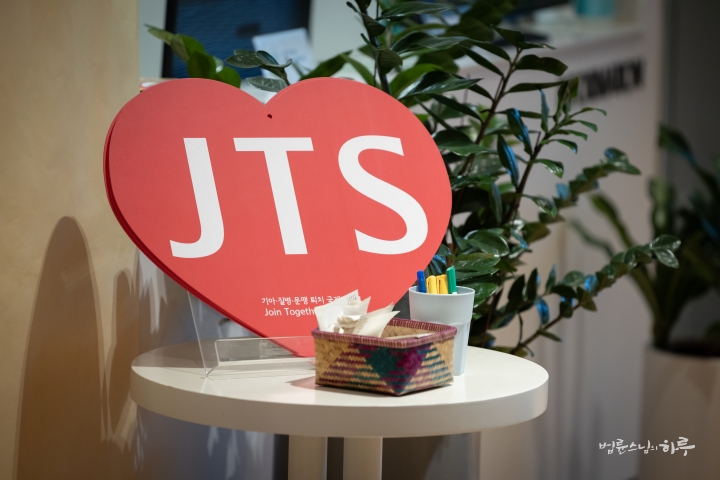
For lunch, volunteers from the Jungto Society Incheon-Gyeonggi West Division prepared kimbap, japchae, salad, bread, and soup. After enjoying the carefully prepared meal, the event concluded.
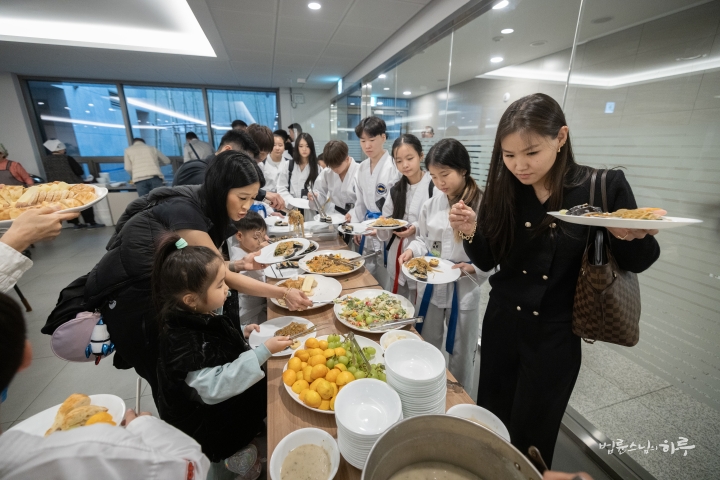
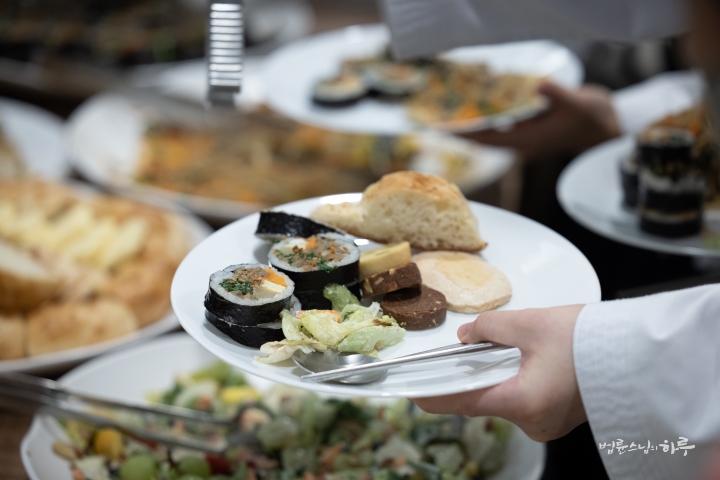
After having lunch with the Goryeoin, Sunim headed to the auditorium on the 9th floor. From 1 PM, he attended the supporters’ workshop held in preparation for the ‘Youth Festa’ scheduled to take place at the Jungto Social and Cultural Center from November 7th to 9th.
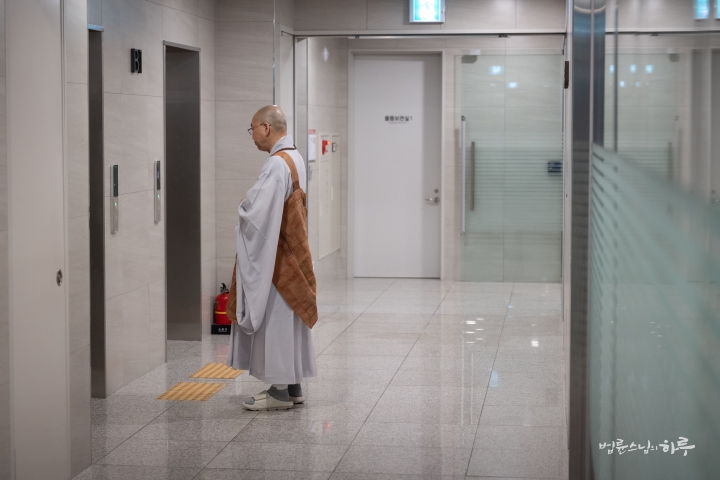
Today’s workshop was organized to review the event preparation progress so far and to unite volunteers in accelerating final preparations. After hearing greetings from the President of Jungto Society, participants had time for introductions. As each department was introduced—Lecture Department, Seminar Department, Booth Department, Publicity Department, Information Department, Support Department—loud applause and cheers erupted.
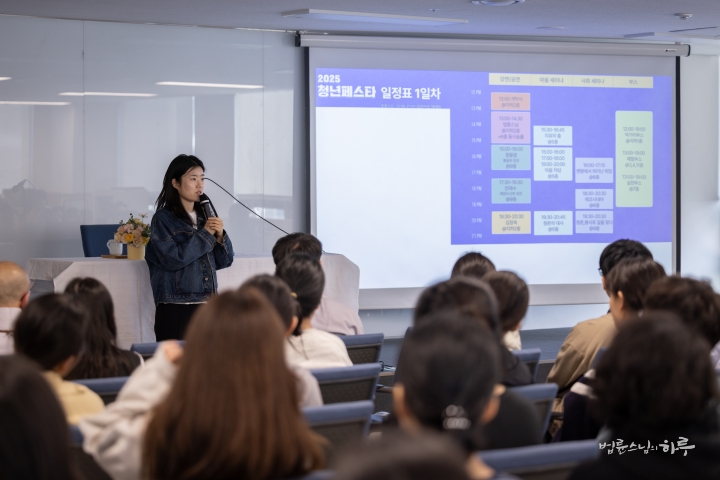
Next, Youth Division Director Park Soo-jung gave a briefing on the Youth Festa preparation status.
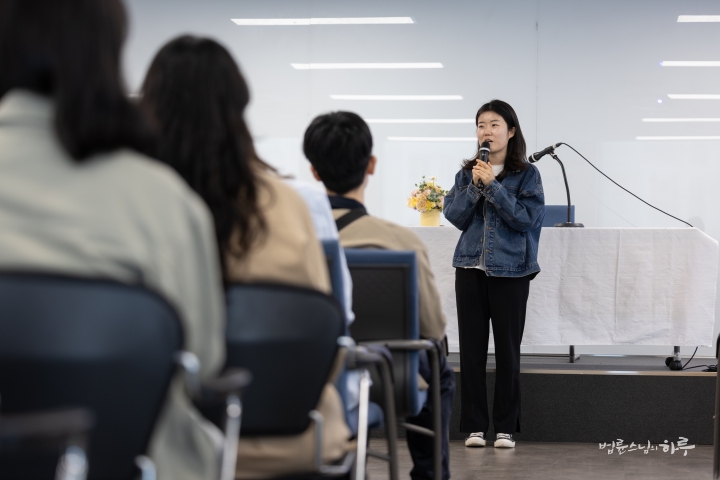
“Let’s transform the Jungto Social and Cultural Center into a festival space where young people can freely share their stories and empathize with each other.”
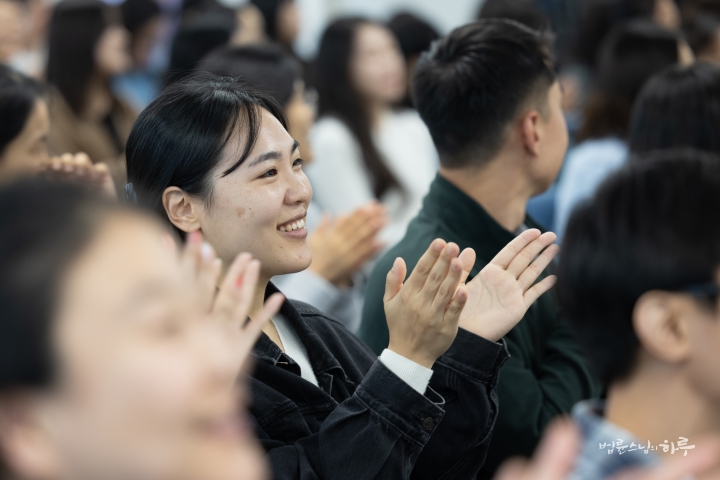
This event, themed ‘Youth, Peace, Future,’ will center around lectures by Venerable Pomnyun Sunim and various speakers including Kim Chang-ok, Kim Je-dong, and Jo In-sung. Experience, seminar, publicity, and action booths will operate throughout all floors of the building. Various programs are being prepared for youth participation and communication, including meditation, performances, environmental film screenings, and DJ parties. The volunteers committed to making thorough preparations for the upcoming event and then requested a Dharma talk from Sunim.
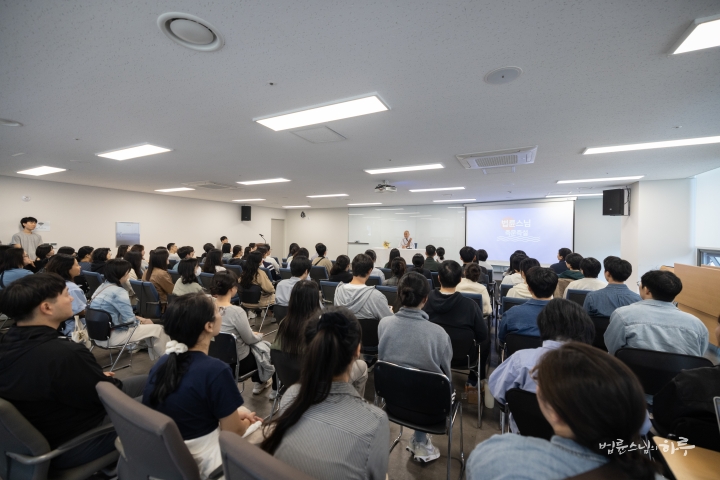
Sunim began the conversation by explaining the reasons for hosting the Youth Festa event.
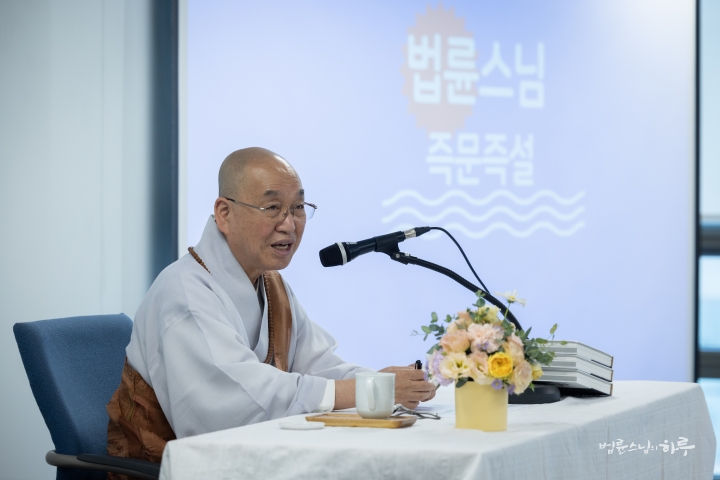
“As you may have heard from the news, there are currently thousands of Korean youth in Cambodia involved with voice phishing criminal organizations. Many are reportedly being assaulted, tortured, or even losing their lives there. While they may have been deceived initially, not knowing what kind of place it was, many young people are still heading to Cambodia despite continuous media coverage. At airports, officials are questioning young people bound for Cambodia about their purpose and preventing departure if their answers are unclear. Yet some are still entering through Vietnam or Thailand, which is truly unfortunate. To put it bluntly, it seems they’re blinded by money and not thinking clearly.
Among Korean youth today, there are reportedly hundreds of thousands of ‘reclusive loners’ who avoid meeting people or stay in their rooms for months or years for various reasons. Even if not to that extent, many spend their time only playing games or cannot become self-sufficient due to lack of employment. Whatever they do, they only want to make big money instantly and are often deceived by claims of earning tens of millions of won in just a few days abroad. This phenomenon is the reality our society faces today. Of course, not all young people are like this, but what was once considered a minority issue is now spreading like a generational characteristic.
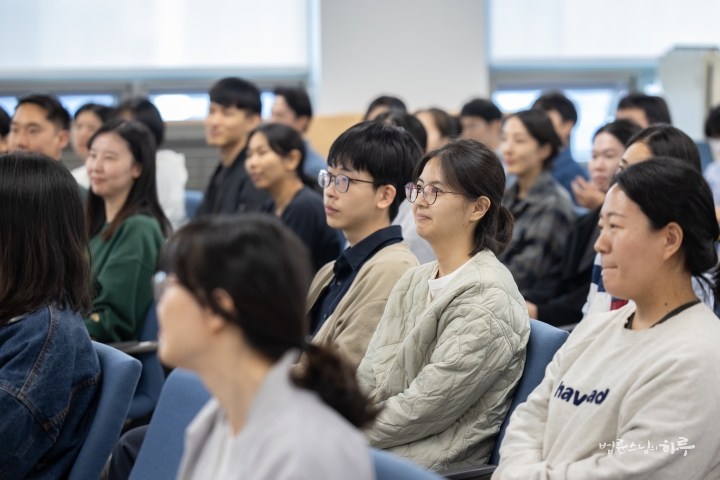
Let’s Give Young People an Opportunity to Create Change
Even among those who have jobs, many focus only on their own affairs and lack social responsibility or community consciousness. Rather than simply criticizing or ignoring this phenomenon, the purpose of organizing the ‘Youth Festa’ event is to create opportunities and occasions for young people to change. The starting point of this event is to help young people who haven’t been leaving their homes reconnect with the world, to help those who have been discouraged regain their confidence, and to help those who only thought about themselves look back at society and the world.
The purpose of this event is not simply to gather many young people. The key is to make even a small splash to create ripples. If we see even a little positive change through this attempt, we plan to expand to other regions or increase the scale for more active implementation next time. Since this is our first attempt, we’re starting small by minimizing costs and utilizing the space at the Jungto Social and Cultural Center, but if it proves meaningful, we will continue even if it requires a budget next time.
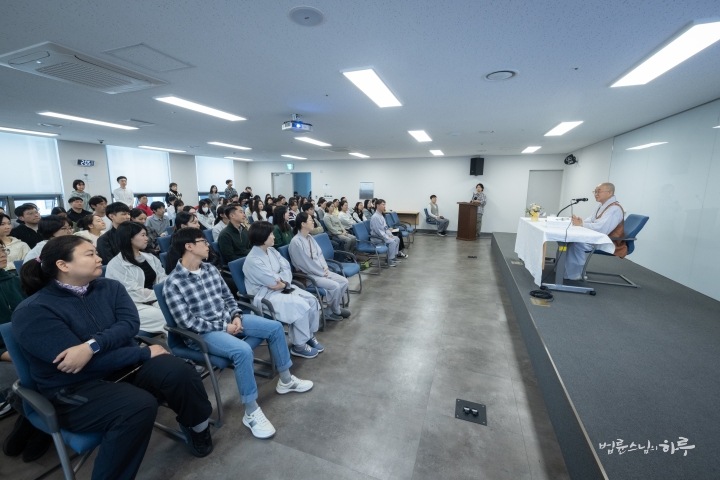
A few days ago, while discussing this event with the President of Dongguk University, there was also a suggestion to utilize the school during vacation. If classrooms or dormitories are used as accommodations, larger-scale events like an international youth conference would be possible. While it’s easy to think that government subsidies or corporate sponsorships are essential for hosting events, we chose not to make excuses like ‘we can’t do it because we don’t have money’ and instead decided to create something ourselves with the resources we have. That is the spirit of this event.
There is no failure in this attempt. At worst, we break even, and the attempt itself becomes ‘practice.’ This practice is most important for young people. Whether it goes well or falls short, doing it builds experience, and that experience gives birth to new ideas and confidence. If we become too greedy, we’ll be discouraged when we fail, but this time there can be no failure. We just need to do our best. Even if the results don’t meet expectations, we can call it the ‘Jungto Youth Playground’ and enjoy it together with Jungto Society members.
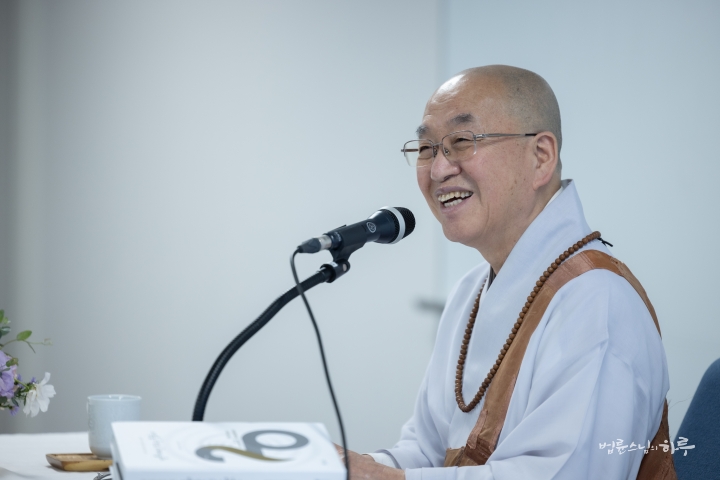
The dice has already been cast. Our goal is 10,000 young people. Even if only half that number—5,000—show up, if each adult brings one young person, we’ll quickly reach 10,000. So this endeavor cannot fail. Go ahead and do it with confidence and to your heart’s content.”
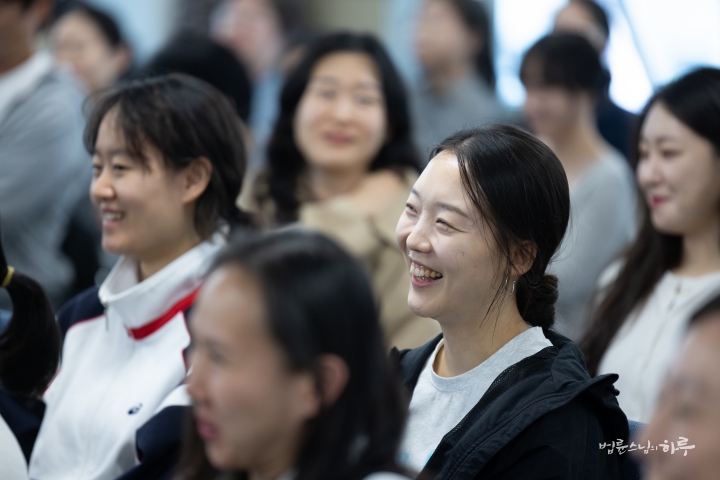
Following this, there was time for free dialogue about difficulties and questions encountered while preparing for the event. Anyone could raise their hand and ask Sunim questions. For an hour and a half, seven people shared their concerns with Sunim. One of them sought Sunim’s advice on how to maintain the boundary between being a ‘worker’ and a ‘practitioner,’ saying that while working, they tend to become attached to results rather than practice.
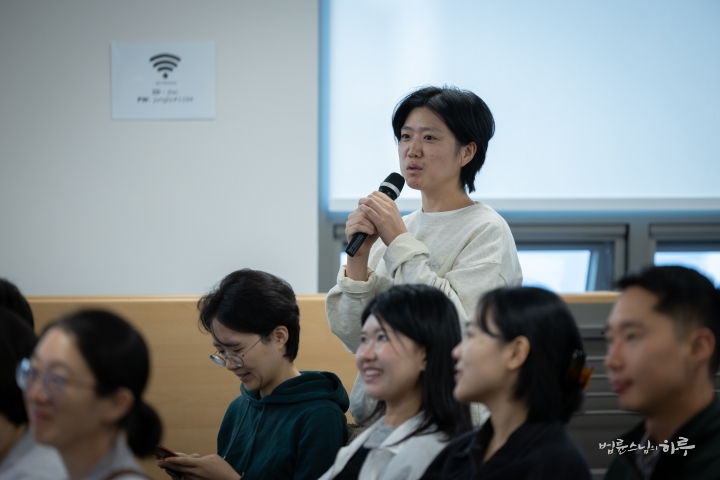
Can I Maintain a Practitioner’s Mind While Doing My Best as a Worker?
“When you’re working, becoming a worker is precisely the practice. A practitioner focuses on eating when eating, and on defecating when defecating. Thinking about defecating while eating, or thinking about eating while defecating—that’s not practice. Fully concentrating on eating when eating, and concentrating on that task when defecating—that is practice. Practice isn’t some special, separate activity.
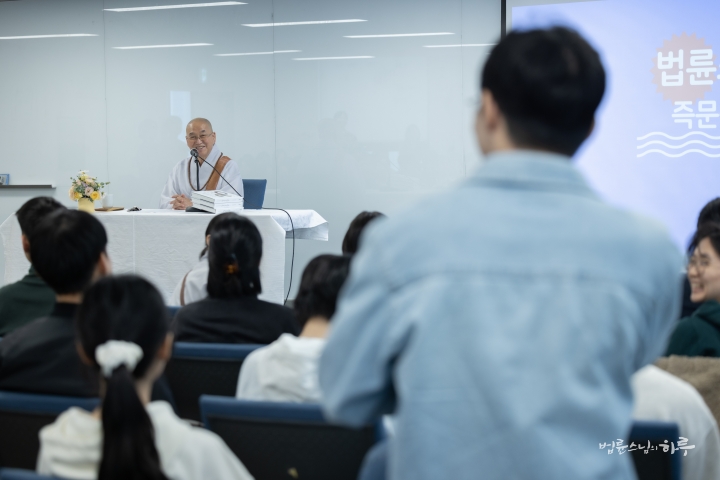
When working, fully concentrating on that work is practice itself. However, if you get angry while working or create conflicts with coworkers, that’s not doing the job well. People often say, ‘Conflicts arose because I was trying to do the job well,’ but in reality, this reduces work efficiency and ultimately ruins the work. Yet work doesn’t automatically go well just because relationships are good either. Most conflicts arise from the attachment to ‘doing the job better.’ If you let go of the desire to do well a little, conflicts will decrease. However, work won’t be done properly if conflicts are left unresolved. Ultimately, what’s important is how to handle conflicts that arise in the process of trying to do work well—without stress and harmoniously. That’s precisely what practice is. Concentrating on work when working and managing your mind in that process—that itself is practice.
Your question, ‘How can I do both work and practice well? When working, isn’t it enough to just do the work well?’ is similar to asking, ‘Whether I get angry or fight, isn’t it okay as long as the results are good?’ To truly do work well, not only technical abilities but also relationships with coworkers are important. Harmoniously balancing these two things—that’s the real way to do work well and simultaneously the path of practice.”
“Thank you. I understand well.”
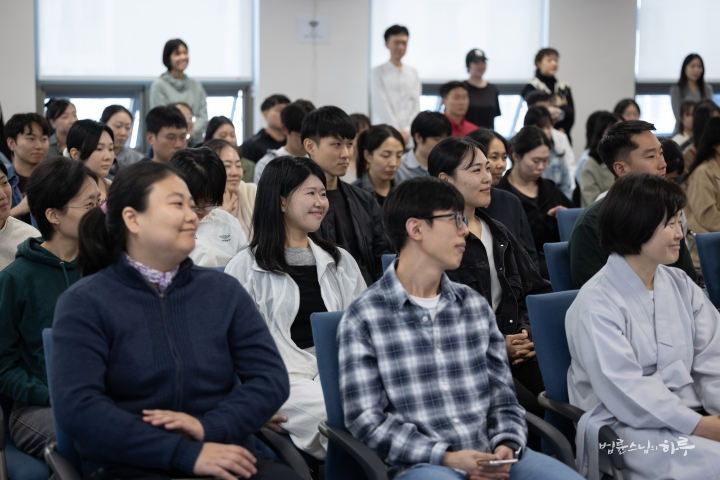
Questions continued to follow.
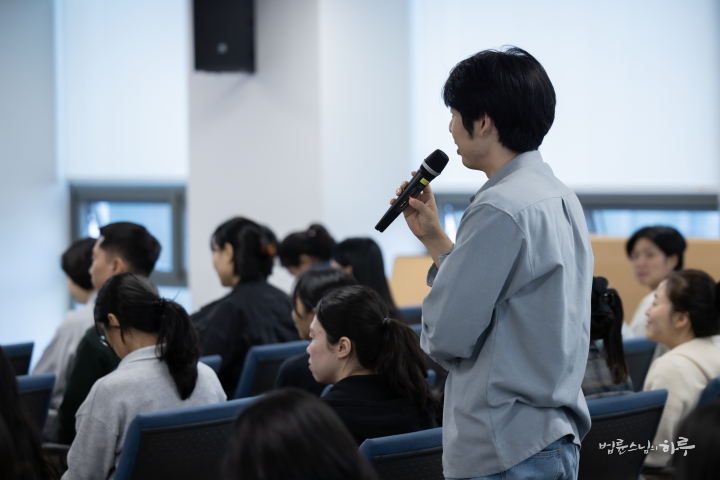
When preparing for the event, there are frequent changes and whenever conflicts of opinion arise, discriminating thoughts come up. Is it right to continue participating in such situations, and what mindset should I have when volunteering?
I’m curious why the number of Youth Festa participants was set at ‘10,000.’ Also, when event preparation feels overwhelming, is there a way to approach it more comfortably?
With many responsibilities and prayer services, it’s hard to focus. Would it be okay to change to a method of dedicating myself for a certain period to improve project quality?
There are many restrictions when creating promotional content, and regulations that don’t match young people’s perspectives are frustrating. Can’t Jungto Society’s policies be opened up more in a direction that young people can relate to?
What social effects can the Youth Festa bring? How can young people’s voices create positive change in the world through this event?
Another young person sought Sunim’s advice on what mindset and leadership are needed when delegating work, as they were experiencing difficulties in communicating with team members while serving as team leader.
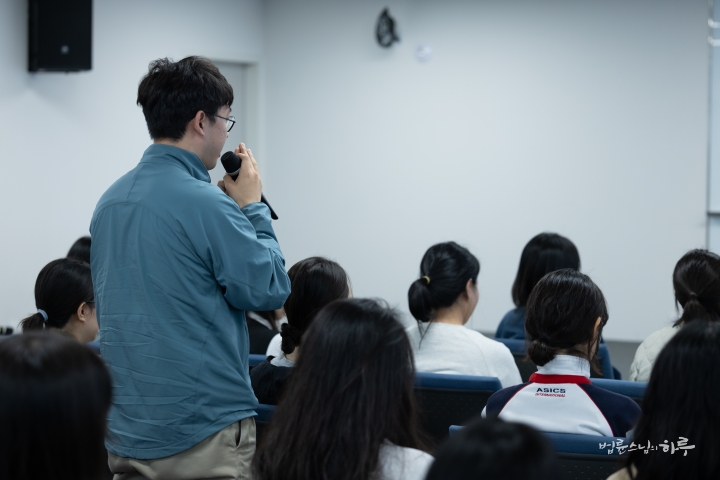
How Can I Lead Work Well and Gain Trust as a Team Leader?
“Running a company is called management. To manage well, two things are important. First is material distribution—the question of where and how much money to invest. Second is human resource distribution—the question of how to deploy and manage personnel. In the past, material factors like capital investment were the core of management, but nowadays, how you deploy people and get them to cooperate has become much more important. After all, the agents doing the work are people.
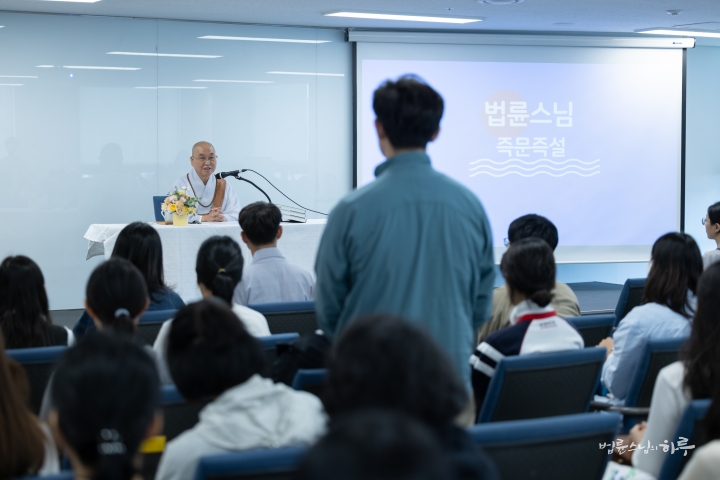
As a team leader, it’s important to first take good care of your team members. This is because work gets done when many people combine their efforts. If team members have their own capabilities and can handle their work well on their own, it’s better for the team leader to reduce unnecessary interference and give them discretion. Instead, support should be provided where needed, but autonomy should be guaranteed as much as possible. By doing so, team members can take responsibility and ownership of their assigned tasks and maximize their capabilities.
On the other hand, if team members still lack experience or ideas, the team leader needs to directly present ideas and set the direction. You need to divide tasks in detail, check progress, and encourage and lead when necessary.
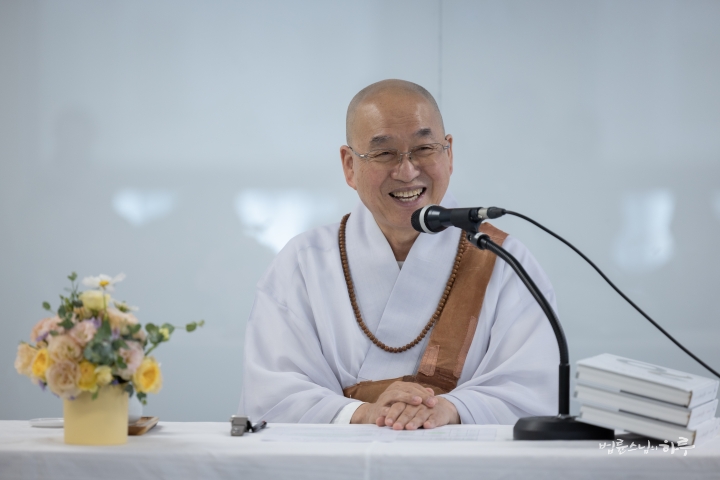
Good management means knowing how to divide work and then bring it together to connect as one. If you only divide work without connecting it, the final product won’t be completed. Conversely, if you don’t know how to divide work, even with many people, only one person ends up working. For example, if you’re leading a team that assembles cars, the team leader should distribute tasks to each member and then gather those pieces together at the end to complete the project. In other words, the team leader’s role should vary depending on the team’s composition and situation. In some cases, strong leadership is needed, while in other cases, giving autonomy can better bring out team members’ talents.
You are currently in the stage of practicing being a team leader. Don’t try to be perfect this time; instead, try various approaches. Try pushing forward, providing support, and accommodating others while gaining experience. This experience will be very helpful when you actually become a team leader at work in the future.
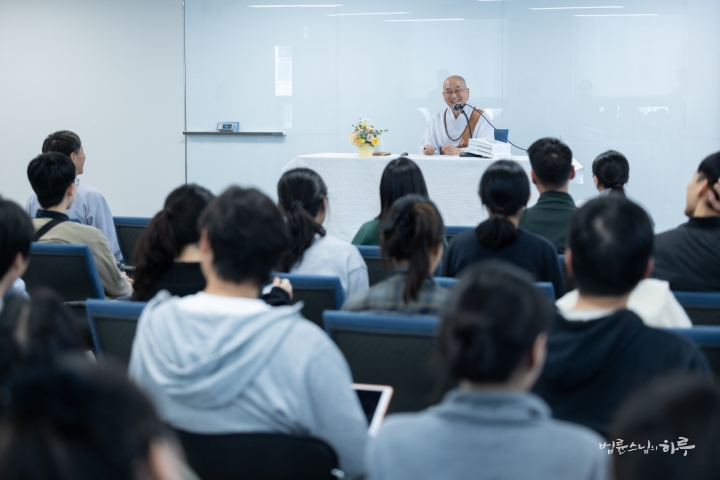
First, discuss the direction with your team members. Once the direction is set, you need to explain the reasons persuasively. If you don’t have good ideas, actively gather opinions from your team members. After establishing the basic design together, divide the work and then bring the results back together to complete it. In other words, the key is the process of dividing and reuniting—achieving harmony between division of labor and integration.
Another important point is the balance between responsibility and achievement. In a company, the team leader must take responsibility for the work. However, in reality, many take credit for achievements while blaming team members when problems arise. This diminishes team members’ motivation. Conversely, when the team leader takes responsibility for problems and shares achievements with team members, trust builds. This kind of leader is someone who manages well.
Finally, first understand your department’s situation. If it’s not clear what needs to be done, don’t rush into work but discuss thoroughly with your team members. If you still can’t find direction, inviting experienced experts for advice is also a good approach.”
“Thank you. I’ll practice.”
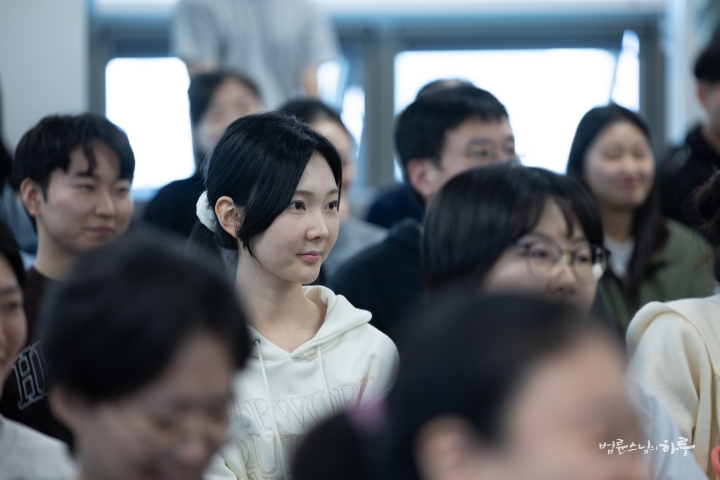
After this conversation, Sunim encouraged the young people to discuss and prepare further among themselves before stepping down from the stage. Finally, they took a commemorative photo with Sunim.
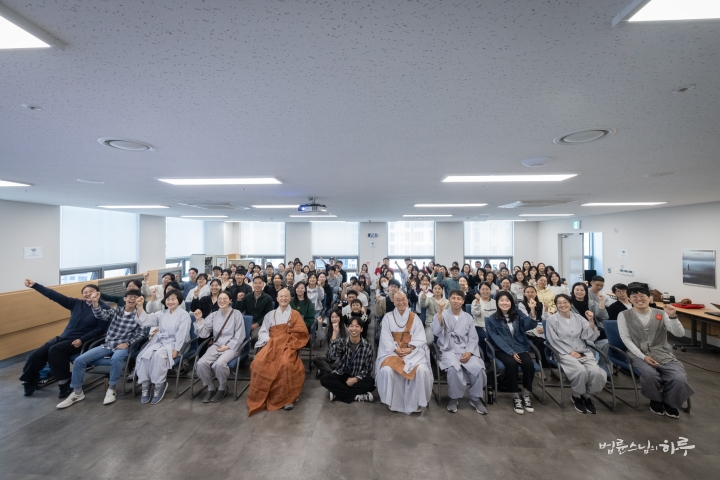
“Youth Festa, fighting!”
The youth supporters gathered by country to discuss difficulties and matters to prepare for the future. After leaving the Jungto Social and Cultural Center, Sunim headed straight to Dubuk Jungto Retreat Center.
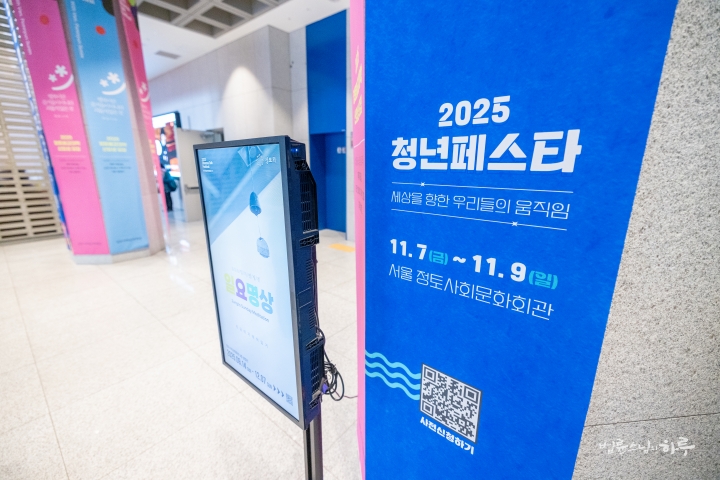
Departing from Seoul at 3:30 PM, after driving on the highway for 4 hours, Sunim arrived at Dubuk Jungto Retreat Center at 7:30 PM.
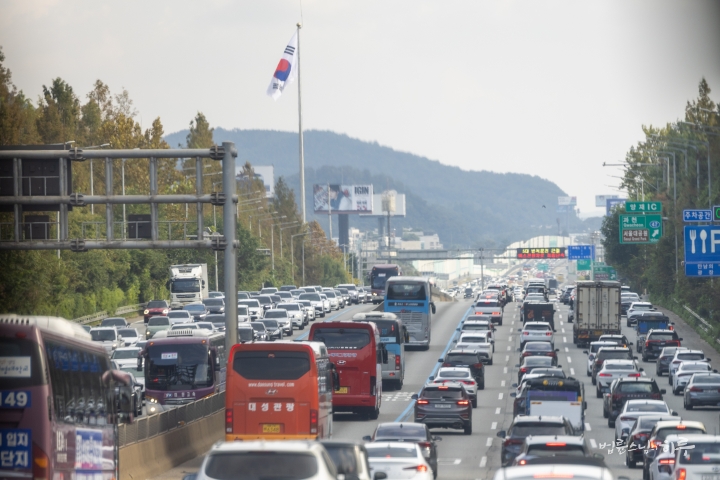
After proofreading manuscripts and handling various tasks, Sunim concluded the day’s activities.
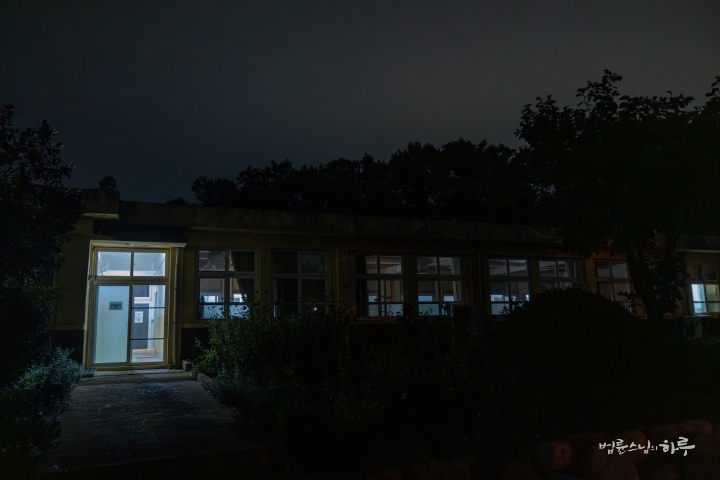
Tomorrow morning, Sunim will travel to Adomoryewon in Gumi to attend the memorial ceremony for Master Yongseong’s enlightenment day. In the afternoon, he will attend the Daegu-Gyeongbuk branch members’ day event and hold a Dharma Q&A session.





